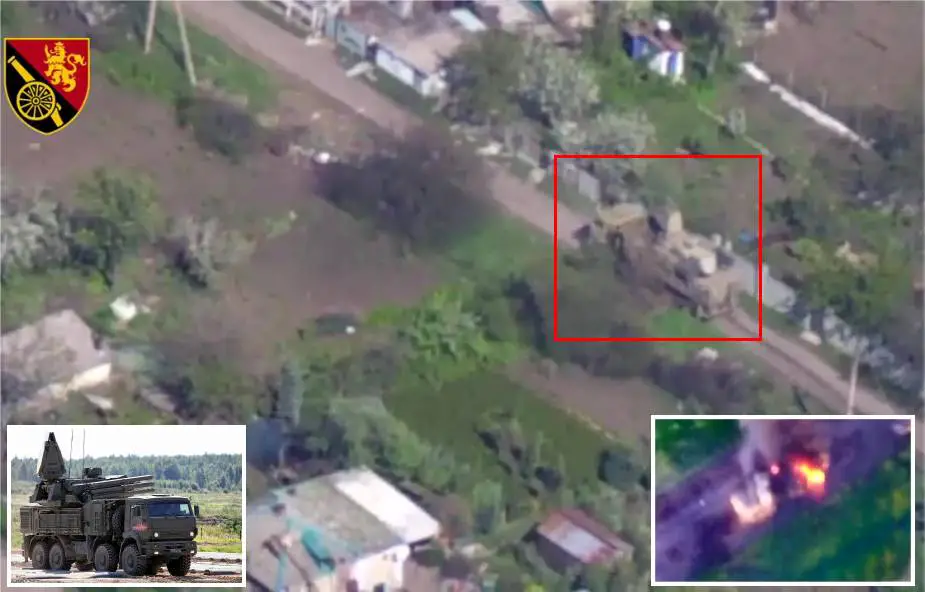According to a video published on Facebook, soldiers from the 45th Artillery Brigade of the Ukrainian Army have destroyed a highly regarded and advanced Russian armed forces air-defense system, the Pantsir-S1, which was heading towards Bakhmut.
Follow Army Recognition on Google News at this link

Ukrainian soldiers of the 45th Artillery Brigade of the Ukrainian Army have destroyed one Russian Pantsir-S1 air defense system. (Picture source Facebook video footage)
The Pantsir-S1, also known by the NATO reporting name SA-22 Greyhound, is a combined short-to-medium range surface-to-air missile and anti-aircraft artillery weapon system produced by Russia. Its role is critical in protecting key military areas, industrial targets, and land troops. It also serves to reinforce the air defense units of other military branches and services.
The Pantsir-S1 is generally regarded as a potent air defense system. Its versatility is one of its standout features. It is designed to offer point air defense of critical installations against a variety of threats including aircraft, helicopters, drones, precision munitions, and even cruise missiles. This makes it highly effective in a wide array of scenarios, whether it's dealing with standard airborne targets or more sophisticated guided munitions.
The system also boasts a high level of automation, which reduces the burden on the operator and can improve reaction times. Its radar system is capable of tracking both aerial and ground targets, providing broad coverage and situational awareness.
The Pantsir-S1's armament consists of 12 57E6 surface-to-air guided missiles and two 2A38M 30mm automatic cannon guns. The missile system provides the Pantsir-S1 with a long-range interception capability of up to 20 kilometers in distance and 15 kilometers in altitude, while the cannons are designed for closer-range targets, up to 4 kilometers in distance and 3 kilometers in altitude.
The 57E6 missile is a two-stage solid-fuel rocket with a high-explosive fragmentation warhead and a contact and proximity fuse. The two 30mm autocannons can fire a variety of rounds, including high-explosive, fragmentation, and armor-piercing, at a rate of 2,500 rounds per minute.

The Pantsir-S1 is considered as one of the most efficient air defense systems by Russian soldiers. (Picture source Vitaly Kuzmin)
The Russian Pantsir-S1 air defense system is equipped with a sophisticated radar and optical control system that enables it to accurately detect, track, and engage both aerial and ground targets.
The radar system on the Pantsir-S1 is a multi-mode adaptive system. It includes a Target Acquisition Radar (TAR) that operates in the E-band. This phased array radar is crucial in providing initial detection and tracking of various targets.
In addition to this, the Pantsir-S1 also has a Target Tracking Radar (TTR), which operates in the J-band. It's used for continuous tracking of targets and missile control. These radar systems work together to provide the Pantsir-S1 with a comprehensive and versatile tracking system.
The radar system's engagement envelope typically covers 360 degrees in azimuth and 82 degrees in elevation. The radar is designed to detect targets at ranges up to 36 kilometers and altitudes up to 15 kilometers, although the specific range can depend on the size and speed of the target.
In terms of engagement, the Pantsir-S1 is designed to engage targets at ranges between 1.2 and 20 kilometers and at altitudes between 0 and 15 kilometers using its missiles. For closer threats, the system's twin 30mm cannons can engage targets up to 4 kilometers away and at altitudes up to 3 kilometers.
The Pantsir-S1's radar and engagement capabilities are built to work in conjunction with each other to provide a highly responsive and effective air defense system. The system can operate in all weather conditions, day or night, and has robust defenses against electronic warfare and countermeasures














